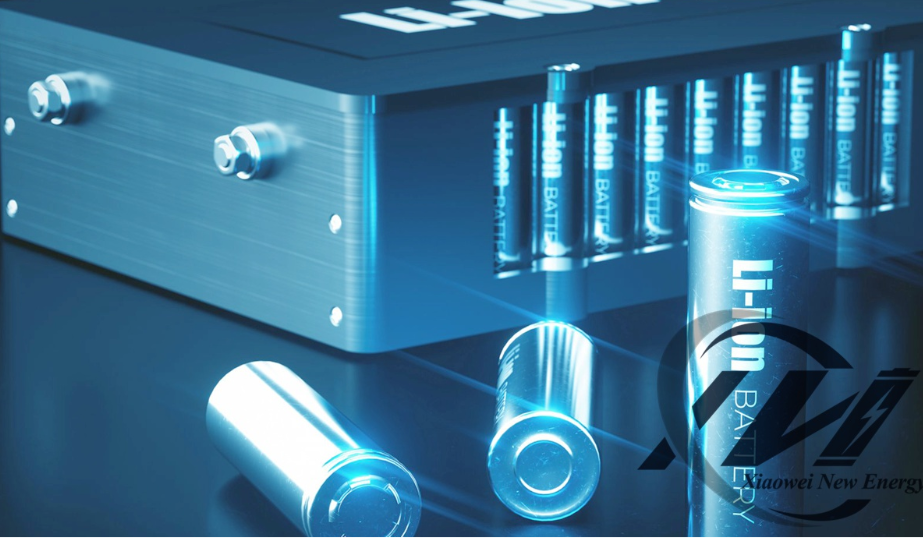As the global demand for energy continues to grow, the application and development of new energy technologies are increasingly becoming the focus of competition among countries. Among them, lithium battery technology has become one of the technologies with the most development potential in the field of new energy with its advantages of high energy density, long life, and environmental protection.
In China, after years of development, the lithium battery industry has formed a complete industrial chain from material research and development, production to application, and has become an important part of the global lithium battery industry. After two cycles, the lithium battery industry chain is standing at a new starting point for growth, and it is expected to usher in new growth momentum in 2025.
According to industry reports, China’s lithium battery production was 8.47 billion in 2016, and increased significantly to 23.93 billion in 2022, with an average annual compound growth rate of 18.9%; from 2021 to 2023, China’s power lithium battery production increased significantly. In 2023, the output of power lithium batteries reached 675GWh, up 23.6% year-on-year. By the end of 2023, the production capacity of power lithium batteries has reached 1500GWh/year. Combined with the progress of power battery investment and expansion projects, it is expected that by 2025, China’s power lithium battery production capacity is likely to reach 3000GWh.
From 2018 to 2022, China’s power lithium battery sales showed an overall upward trend. Driven by the sharp increase in the production and sales of new energy vehicles and the increase in the export of power lithium batteries, China’s power lithium battery sales increased significantly. In 2023, the sales of power lithium batteries reached 616.3GWh, up 32.4% year-on-year. From January to November 2024, the cumulative sales of power batteries increased by 27.1% year-on-year.
This article will introduce the top 10 most promising new lithium battery materials in the future.
1.Silicon-Carbon Composite Anode Materials
With the large screen and diversified functions of digital terminal products, new requirements are put forward for battery life. The current gram capacity of lithium battery materials is low and cannot meet the growing demand for batteries in terminals.
As a kind of future negative electrode material, the theoretical gram capacity of silicon-carbon composite materials is about 4200mAh/g or more, which is more than 10 times higher than the 372mAh/g of graphite negative electrodes. After its industrialization, it will greatly increase the capacity of batteries. The main problems of silicon-carbon composite materials are:
- During the charging and discharging process, the volume expansion can reach 300%, which will cause the silicon material particles to pulverize and cause the material capacity loss. At the same time, the liquid absorption capacity is poor.
- Poor cycle life: The above problems are currently being solved through silicon powder nano-crystallization, silicon-carbon coating, doping and other means, and some companies have made certain progress.
Relevant R&D companies in China: Currently, major material manufacturers are developing silicon-carbon composite materials. The situation of domestic negative electrode material companies developing silicon-based materials is that most material suppliers are still in the R&D stage, and currently only Shanghai Shanshan has entered the pilot mass production stage.
2. Lithium Titanate
Lithium titanate battery is a lithium-ion battery whose positive electrode material is lithium titanate (Li₂TiO₃) and negative electrode material is carbon material. Compared with traditional lithium-ion batteries, lithium titanate batteries have advantages such as higher safety, longer service life and faster charging speed. The positive electrode material of lithium titanate battery, lithium titanate, has high chemical stability and thermal stability, which can improve the safety performance of the battery. At the same time, lithium titanate also has good electrochemical properties and cycle stability, and can maintain long-term high capacity and long life.
The negative electrode material of lithium titanate battery uses carbon material, such as natural graphite, artificial graphite, carbon fiber, etc. This negative electrode material has a high specific capacity and a long service life. At the same time, the electrolyte of lithium titanate battery usually adopts an anhydrous organic solution system, such as a mixture of dimethyl carbonate (DMC) and acrylonitrile (AN), which can improve the charging speed and energy density of the battery. Due to its safety, long life and fast charging advantages, lithium titanate batteries are widely used in electric vehicles, power tools, solar cell energy storage systems, power tools and other fields.
In recent years, the enthusiasm for the research and development of lithium titanate has been high. The main advantages of lithium titanate are:
- Long cycle life (up to 10,000 times or more), zero strain material (volume change is less than 1%), no traditional SEI film is generated.
- High safety: It has a high lithium insertion potential, does not generate dendrites, and has extremely high thermal stability during charging and discharging.
- Can be charged quickly.
The main factor currently limiting the use of lithium titanate is that the price is too high, higher than traditional graphite, and the gram capacity of lithium titanate is very low, about 170mAh/g. Only by improving the production process and reducing the production cost can the advantages of lithium titanate such as long cycle life and fast charging play a role. Combined with the market and technology, lithium titanate is more suitable for energy storage fields that do not require space.
3. Graphene
Graphene can be applied to graphene negative electrode composite materials for power batteries, positive electrode conductive agents for lithium batteries, and graphene functional coated aluminum foil, etc., by taking advantage of its ultra-thin and ultra-light, excellent electrochemical properties, high specific surface area, electronic and ion conductivity, and special two-dimensional single atomic layer structure. This can greatly reduce the weight of the battery, thereby reducing the quality of the entire vehicle, extending the battery life, and greatly improving the range and charging speed of electric vehicles.
Graphene is directly used as anode materials. Advantages of graphene direct lithium storage:
- High specific capacity: Lithium ions are embedded and deintercalated in graphene at a non-stoichiometric ratio, and the specific capacity can reach 700~2000 mAh/g.
- High charge and discharge rate: The interlayer distance of multilayer graphene materials is significantly larger than the interlayer distance of graphite, which is more conducive to the rapid embedding and deintercalation of lithium ions. Graphene has good conductivity, but its two-dimensional microstructure is easy to stack with each other, which makes the research on independent graphene electrode materials not ideal. It is mainly manifested in poor battery rate performance and low cycle efficiency.
Since winning the Nobel Prize in 2010, graphene has attracted worldwide attention, especially in China. A wave of research and development of graphene has been set off in China. It has many excellent properties, such as good light transmittance, excellent electrical conductivity, high thermal conductivity, and high mechanical strength. The potential applications of graphene in lithium-ion batteries include:
As Lithium battery materials (anode materials): graphene has a high gram capacity, with a reversible capacity of about 700mAh/g, which is higher than the capacity of graphite negative electrodes. In addition, graphene’s good thermal conductivity ensures its stability in the battery system, and the interlayer spacing of graphene sheets is larger than that of graphite, so that lithium ions can diffuse smoothly between graphene sheets, which is beneficial to improving battery power performance. Due to the immature production process of graphene and its unstable structure, there are still some problems with graphene as a negative electrode material, such as low first discharge efficiency of about 65%; poor cycle performance; high price, which is significantly higher than traditional graphite negative electrodes.
As cathode and anode additives: it can improve the stability of lithium batteries, extend cycle life, and increase internal conductivity.
Given that graphene’s current mass production process is immature, expensive, and has unstable performance, graphene will first be used as a cathode and anode additive in lithium-ion batteries.
4. Carbon Nanotubes
Carbon nanotubes are a type of carbon material with a graphitized structure. They have excellent electrical conductivity. At the same time, due to their small depth and short travel when deintercalating lithium, they have little polarization effect when used as negative electrode materials during high-rate charge and discharge, which can improve the high-rate charge and discharge performance of the battery.
In the application of lithium batteries, when carbon nanotubes are used as conductive agents, their unique network structure can not only effectively connect more active substances, but also their excellent conductivity can significantly reduce impedance. In addition, carbon nanotubes with a larger aspect ratio have a larger specific surface area. Compared with traditional conductive agents Super P and graphite, it only needs a small amount of addition to form an efficient three-dimensional high-conductive network in the electrode and achieve the goal of improving battery energy density. Therefore, further research and development of new carbon nanotube conductive agents is the focus of future attention. According to statistics from authoritative departments, by 2023, the penetration rate of carbon nanotube conductive agents in China’s lithium-ion power battery market will reach 82.2%.
Disadvantages: When carbon nanotubes are directly used as negative electrode materials for lithium batteries, there will be problems such as high irreversible capacity, voltage hysteresis, and unclear discharge platform. For example, Ng et al. prepared single-walled carbon nanotubes by simple filtration and used them directly as negative electrode materials. Their first discharge capacity was 1700mAh/g and their reversible capacity was only 400mAh/g.
Another application of carbon nanotubes in negative electrodes is to compound with other negative electrode materials (graphite, lithium titanate, tin-based, silicon-based, etc.), using their unique hollow structure, high conductivity and large specific surface area as carriers to improve the electrical properties of other negative electrode materials.
5. Lithium-Rich Manganese-Based Cathode Materials
High capacity is one of the development directions of lithium batteries, but the energy density of lithium iron phosphate in the current positive electrode materials is 580Wh/kg, and the energy density of lithium nickel cobalt manganese oxide is 750Wh/kg, both of which are relatively low. The theoretical energy density of lithium-rich manganese-based materials can reach 900Wh/kg, becoming a hot spot for research and development.
Lithium-rich manganese-based positive electrode materials are a type of lithium-ion battery positive electrode material. Under the background of “carbon neutrality”, the global new energy vehicle market penetration rate has increased rapidly, and the demand for power batteries is strong. Compared with the common lithium-ion battery positive electrode materials at this stage, lithium-rich manganese-based positive electrode materials have high specific capacity and strong endurance. They are the next generation of new energy vehicle lithium-ion battery positive electrode materials with great development potential.
Industry analysts said that lithium-rich manganese-based positive electrode materials have high discharge specific capacity and are one of the products with the highest discharge specific capacity among the known lithium-ion battery positive electrode materials. It is much higher than the common ternary materials and lithium iron phosphate positive electrode materials in the market. It can manufacture high-energy density power batteries and improve the endurance of power batteries. In addition, the cobalt and nickel content in lithium-rich manganese-based positive electrode materials is only about 30% of that in ternary materials, and it can also be cobalt-free, which further reduces its cost. Its safety performance is also higher than that of ternary material batteries, so it has become a highly promising next-generation lithium-ion battery positive electrode material.
Lithium-rich manganese-based positive electrode materials have the advantages of high discharge specific capacity, high discharge voltage, high energy density, low cost, high safety, and long cycle life, and have great market potential in the future. At present, there are a series of problems with lithium-rich manganese-based materials:
- The first discharge efficiency is very low;
- The material releases oxygen during the cycle, which poses a safety hazard;
- The cycle life is very poor;
- The rate performance is low.
At present, the means to solve these problems include coating, acid treatment, doping, pre-cycling, heat treatment, etc. Although lithium-rich manganese-based has obvious advantages in gram capacity and huge potential, it will take time for it to be put on the market in large quantities due to the slow progress of technology. The research on lithium-rich manganese-based positive electrode material technology is constantly deepening. When the existing bottleneck problems are solved, it is expected to achieve industrial development.
6. Power-type Nickel-Cobalt-Manganese-Oxide Lithium Materials
There has always been a lot of controversy over the route of power batteries, so lithium iron phosphate, lithium manganese oxide, ternary materials and other routes have been adopted. The domestic power battery route is mainly lithium iron phosphate, but as Tesla has become popular all over the world, the ternary material route it uses has caused a wave of enthusiasm.
Although lithium iron phosphate is highly safe, its low energy density is an insurmountable weakness, and new energy vehicles require longer driving range. Therefore, in the long run, materials with higher gram capacity will replace lithium iron phosphate and become the next generation mainstream technology route.
Nickel cobalt manganese oxide ternary material is most likely to become the mainstream material for the next generation of power batteries.
7. Coating Battery Separator
At present, the Chinese diaphragm market is dominated by wet-process diaphragms. Although wet-process diaphragms are ahead of dry-process diaphragms in performance, there are still some defects in actual applications. In order to further improve the performance of wet-process diaphragm products, various manufacturers continue to increase their research on the production process of diaphragm products, and gradually form a coating process that coats specific materials on the basis of the original diaphragm.
Coating is essentially a modification method. By coating specific materials, the performance of the base film is changed to meet more diversified needs. The use of coating technology can effectively enhance the thermal stability and mechanical properties of the diaphragm. Coating materials can be divided into two types: coating particles and coating solvents. Coating particles include two major categories: organic and inorganic.
- Inorganic materials mainly include boehmite, alumina, etc.;
- Organic materials include PVDF, aramid, etc.;
Coating solvents can be divided into water-based and oil-based. The uniformity and viscosity of oil-based coating are better than those of water-based coating, and the cost is relatively high. Overseas battery manufacturers prefer it.
In the current diaphragm market, the production process of inorganic coated diaphragms is more mature, and the products produced have better tensile strength and thermal shrinkage, and the cost is lower. Therefore, inorganic coated diaphragms occupy the vast majority of the coated diaphragm market. Since 2019, the proportion of inorganic coated diaphragm products in the total coated diaphragm products has been increasing. In 2021, inorganic coating accounted for more than 95% of coated diaphragms.
Battery separators are crucial to the safety of lithium batteries, which requires the separators to have good electrochemical and thermal stability, as well as to maintain high wettability to the electrolyte during repeated charging and discharging.
Coating separators refers to coating adhesives such as PVDF or ceramic alumina on the base film. The functions of coating separators are:
- Improve the heat shrinkage resistance of the separator and prevent the separator from shrinking and causing large-area short circuits.
- The coating material has low thermal conductivity, which prevents certain thermal runaway points in the battery from expanding to form overall thermal runaway.
8. Ceramic Alumina
Among coated diaphragms, ceramic coated diaphragms are mainly targeted at power battery systems, so their market growth space is larger than that of rubber-coated diaphragms. The market demand for their core material, ceramic alumina, will increase significantly with the rise of ternary power batteries.
The purity, particle size and morphology of ceramic alumina used to coat the diaphragm are very high. The products of Japan and South Korea are more mature, but the price is more than twice that of China.
Alumina is a high-hardness compound with a melting point of 2054°C and a boiling point of 2980°C. It is an ion crystal that can be ionized at high temperatures. As an inorganic substance, alumina has high thermal stability and chemical inertness, and is a good choice for ceramic coating of battery diaphragms. Its advantages are:
- Long cycle life: Reduces mechanical micro-short circuits during the cycle process and effectively improves the cycle life.
- High rate performance: High-purity nano-alumina can form a solid solution in lithium batteries to improve rate performance and cycle performance.
- High-purity nano-alumina also has very good thermal conductivity: When the battery temperature is too high, this material can conduct heat well, thus solving the problem of poor thermal conductivity of PP/PE materials.
- Good wettability: High-purity nano-alumina powder has good liquid absorption and liquid retention capabilities.
- High-purity nano-alumina materials also have excellent flame retardancy: This is because alumina materials themselves are very good flame retardants. Even if the temperature is too high and reaches the zero point of combustion, the good flame retardancy of the material will prevent large-scale combustion or even explosion.
- When the current is too large, it can block the current: As the capacity of lithium-ion batteries continues to increase, the internal energy accumulated becomes larger and larger, and the internal temperature will increase. It is possible that the temperature is too high to melt the negative electrode diaphragm and cause a short circuit.
9. High-Voltage Electrolyte
Improving battery energy density is one of the trends of lithium batteries. At present, there are two main methods to improve energy density: one is to increase the charging cut-off voltage of traditional positive electrode materials, such as increasing the charging voltage of lithium cobalt oxide to 4.35V and 4.4V. However, the method of increasing the charging cut-off voltage is limited. Further increasing the voltage will cause the structure of lithium cobalt oxide to collapse and its properties to be unstable; another method is to develop new positive electrode materials with higher charging and discharging platforms, such as lithium-rich manganese-based and nickel cobalt oxide.
After the voltage of the positive electrode material is increased, a high-voltage electrolyte is required to match it. Additives play a key role in the high-voltage performance of the electrolyte, which has become the focus of research and development in recent years.
With the continuous development of lithium-ion batteries towards high energy density, research on high-voltage battery electrolyte has become more and more in-depth. At present, new high-voltage electrolytes include sulfones, nitriles, ionic liquids and fluorinated electrolytes. These new system electrolytes can meet the needs of high voltage to a certain extent.
Sulfone electrolytes
Sulfone electrolytes are low-cost and have an electrochemical window of more than 5V, making them potential high-voltage electrolytes for lithium-ion batteries. Sulfones and carbonates can be used as co-solvents to optimize the compatibility of sulfones with positive electrode materials, and also provide new ideas for the development of high-voltage electrolytes. Sulfone solvents have high melting points, most sulfones are solid at room temperature, and have poor compatibility with positive electrode materials. Solving these problems will make sulfone electrolytes more widely used.
Nitrile electrolyte
Nitrile substances have a series of advantages, such as high thermal stability, good anode stability, wide liquid temperature range, etc. The most prominent feature is the wide electrochemical window. The oxidation stability of single nitrile can reach 7V, and it is difficult to decompose in the usual 5V high-voltage lithium-ion battery. Nitrile solvents are more stable than carbonate solvents at high voltage and have better performance at low temperatures. However, they have poor compatibility with negative electrodes such as graphite or metallic lithium, and will polymerize at the negative electrode. The generated polymer will hinder the deintercalation of lithium ions. Therefore, how to solve its compatibility with negative electrode materials and play to its strengths and avoid its weaknesses is the only way for it to be used in high-voltage electrolytes for lithium-ion batteries.
Fluorinated electrolytes
Fluorine atoms have strong electronegativity and weak polarity. Fluorinated solvents have excellent chemical stability and have great potential in the application of high-voltage electrolytes. How to develop fluorinated electrolytes with excellent performance is the goal of scientific researchers.
Ionic liquids
Ionic liquids have low volatility, excellent flame retardancy, and a wide electrochemical window. Recently, they have been widely studied and can improve the stability of lithium-ion batteries at high voltages. The disadvantage is that the coulombic efficiency of the battery is only about 95% after using the ionic liquid, and the capacity decays rapidly. Therefore, the coulombic efficiency needs to be improved to truly achieve high efficiency and high capacity retention. To improve its shortcomings, ionic liquids and conventional solvents can be used as co-solvents to improve the performance of lithium-ion batteries at high voltages.
Although ionic liquids can be used in high-voltage lithium-ion batteries, their high viscosity and low conductivity lead to reduced battery cycle and rate performance; secondly, their poor wettability leads to poor compatibility with electrodes; thirdly, ionic liquids have a high melting point, which reduces performance at low temperatures. More research is needed before ionic liquids can be truly applied.
10. Water-Based Adhesive
At present, the positive electrode material mainly uses PVDF as a binder and is dissolved with an organic solvent. The binder system of the negative electrode includes SBR, CMC, fluorinated olefin polymers, etc., and organic solvents are also used. In the process of electrode sheet production, the organic solvent needs to be dried and volatilized, which not only pollutes the environment but also harms the health of employees. The dried and evaporated solvent needs to be collected and treated with special refrigeration equipment, and the fluorinated polymer and its solvent are expensive, which increases the production cost of lithium batteries.
The rigidity, hardness and creep resistance of PVDF are particularly outstanding. Its processing and molding properties are much better than PTFE, and it is the toughest fluoroplastic. The radiation resistance and mechanical properties of PVDF are greatly improved, and the tensile strength can reach 50MPa, which is almost twice that of PTFE. It not only has excellent processing properties, but also greatly improves its adhesion to the metal surface, which greatly improves the life and reliability of the rotating lining with metal materials. The bond distance of the C-F bond in its carbon-fluorine molecular chain is small and the bond energy is low. This short-bond structure forms the most stable and firm bond with hydrogen ions. It has strong wear resistance and impact resistance, and has high anti-fading and anti-ultraviolet properties in extremely harsh and adverse environments. It has a low melting point (about 170°C), good processing performance, and is easy to mold. It can be molded by general thermoplastic processing methods, such as injection, molding, extrusion, blow molding, etc. It is the only material among fluoroplastics that can be made into hard tubes. It has high impact strength and wear resistance, and is the toughest among fluoroplastics. It can be used for a long time in the temperature range of -62°C to 150°C, has high heat resistance, and outstanding weather aging resistance. The polar distance of the C-F bond in its carbon-fluorine molecular chain is large, and it is a polymer with extremely high polarity and excellent dielectric properties. These excellent properties are used in wire and cable insulation materials for automobiles, aviation, and robots, and pipeline lining coatings for transmitting special liquids.
However, SBR/CMC binders are easy to stick to rollers during processing, and are difficult to use in the preparation of positive electrode sheets, so their scope of use is limited. For reasons of environmental protection, cost reduction, and increased electrode performance, the development of water-based adhesives is imperative.






